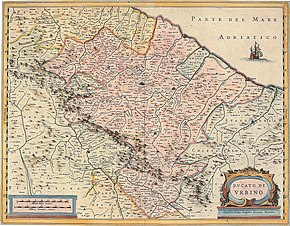Duchy of Urbino Ducato di Urbino (Italian) | |||||||||
|---|---|---|---|---|---|---|---|---|---|
| 1443–1631 | |||||||||
 The Duchy of Urbino in the 17th century | |||||||||
| Capital | Urbino (1443–1523) Pesaro (1523–1631) | ||||||||
| Official languages | Italian | ||||||||
| Religion | Roman Catholicism | ||||||||
| Government | Duchy | ||||||||
| Duke | |||||||||
• 1443–1444 | Oddantonio da Montefeltro (first) | ||||||||
• 1623–1631 | Francesco Maria II della Rovere (last) | ||||||||
| Historical era | Renaissance, Early modern period | ||||||||
| 1443 | |||||||||
• The duchy is annexed to the Papal States | 1631 | ||||||||
| |||||||||
| Today part of | Italy | ||||||||

The Duchy of Urbino (Italian: Ducato di Urbino) was an independent duchy in early modern central Italy, corresponding to the northern half of the modern region of Marche. It was directly annexed by the Papal States in 1631.
It was bordered by the Adriatic Sea in the east, the Republic of Florence in the west and the Papal States in the south. In 1523 the capital was moved from Urbino to Pesaro. After the short rule by Cesare Borgia in 1502–08, the dukedom went to the della Rovere papal family, who held it until 1625, when Pope Urban VIII annexed it to the Papal States as Legazione del Ducato di Urbino (later Legazione di Urbino).

